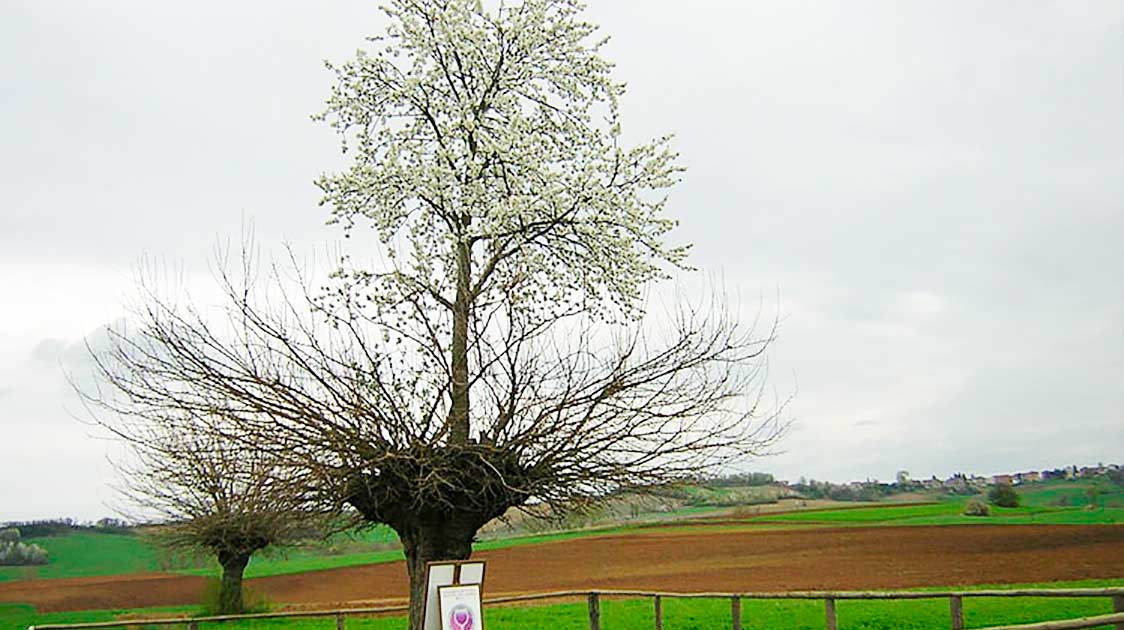
The double tree of Casorzo
A non-parasitic plant that grows on a tree is called an epiphyte. Typically, epiphytes are small and consist of things like mosses, lichens, and ferns, but there are rare instances when they grow much, much larger.
Take, for instance, the Double Tree of Casorzo in Asti, Piemonte, Italy. This tree is also known as Bialbero di Casorzo in Italian. The tree consists of a mulberry tree on the bottom with a cherry tree on top. These trees aren’t grafted together, the cherry tree just happened to grow on top. As it grew, its roots extended down through the hollow trunk of the mulberry tree into the soil below. It is believed that a bird relocated the cherry pit onto the tree and was not the result of human intervention.
Both trees appear to be in great health, with no signs of slowing down. This is rather exceptional, as trees as epiphytes usually don’t grow anywhere near this large or live this long because of a lack of nutrients and resources. The mulberry tree’s hollow trunk—which can be disastrous for a tree—appears to be the secret for longevity for this double tree. When trees develop hollow trunks, they can potentially become very unstable and fall over. However, the cherry tree’s root system taking up the space in the middle of the mulberry tree’s trunk could be giving it the added stability needed for both trees to stay alive.
Trees like the Double Tree of Casorzo are exceedingly rare. There have been rumors that a similar peach/spruce combination was spotted in the Plitvice Lakes National Park in Croatia during the 1960s, though its existence was never confirmed.
What do you hope will be remarkable about the tree you leave behind in your Bios Urn?
Join our mailing list to keep you updated of all Bios® news and get a 10% Discount!








Does the Cherry Tree provide any fruit ?
If it is a Prunus avium, it does!
A interesting form of plant-plant mutualism.
Hi – cant tell you how excited l am to read about “Epiphytes”. I have some of these trees in far north west NSW, Australia. The 2 most robust of these tree in trees are Wilga (Geijera parviflora) growing inside a Bimblebox (Eucalyptus populnea). They would be over 200 years old l think and may have been grafted or grown by the local Kamilaroi people ( indigenous Australians ) would you like to see some photos ?
Yes please Jane! See if you can share them here for all to see! If not, you can send them to [email protected]. Thank you so much for reaching out!
That’s great
I have a white pine tree growing in a crotch (of limb and trunk) of my very old, not hollow pear tree. Is the pine tree, appx 4′ tall, a harm to the pear tree?
Dear Pat! I am afraid that we are not gardening specialists, we provide information relating to our biodegradable urns that turn you into a tree in the after-life. We suggest you contact your local tree nursey or continue your search online. Take care and happy new year!
Hi! I have a cone like tree that has a totally different tree growing of the top of it and I would love is you could look at my pictures of it and explain what I have? I would really appreciate it if you would allow me to send you the pictures. Thank you so much!
Alana
Hi Alana! Feel free to reach out to us at [email protected], however we are in no means horiculture experts. We like talking and writing about trees after doing some research, but we think that was tree identification, best to contact a tree nursery or horiculturist and they can hopefully help you identify the tree species. Thanks!
I found this article because I came across a damson tree growing out of a hawthorn tree on my property! I couldn’t understand how it could be the case – but this explains it.
Wow that must be pretty spectacular!